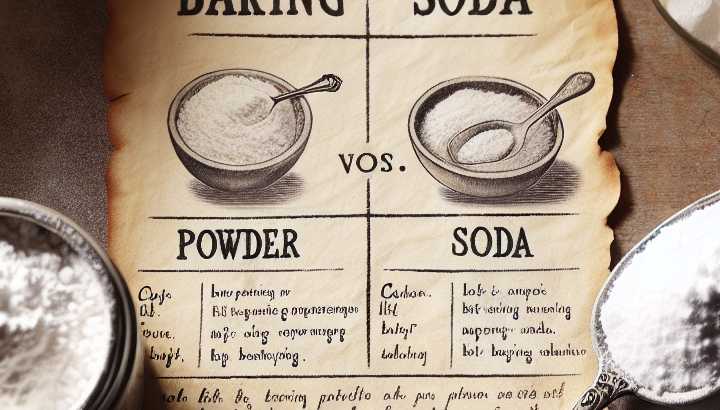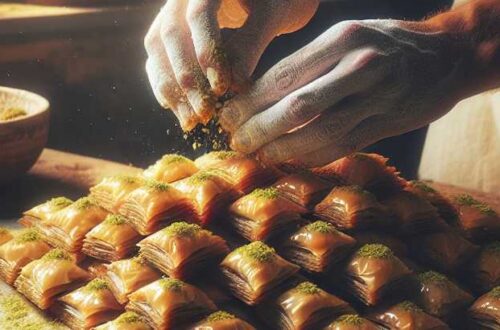Baking Powder vs Baking Soda

Chemical composition of baking soda and powder
Title: Puff Up with Knowledge: The Chemical Hustle of Baking Soda and Powder
Hold onto your measuring cups, science and baking enthusiasts! We’re embarking on an epic culinary quest into the microscopic universe hidden in our unassuming kitchen cupboards. Our lead characters? The powerful dynamic duo: baking powder and baking soda. Now, don’t let their plain appearances deceive you. Inside these simple white powders, there’s a dramatic soap opera of chemistry that could put most reality TV to shame.
First up to bat is our debonair particle protagonist, baking soda, scientifically known as sodium bicarbonate. But you can call it NaHCO3, if you’re into the whole brevity thing. It’s that ‘Na’ for sodium, ‘H’ for hydrogen, ‘C’ for carbon, and those three hilarious ‘O’s for oxygen that truly make baking soda pop. Together, they join hands to form a compound that’s a textbook example of “It’s what’s inside that counts.”
Here’s where the plot thickens. When baking soda is privy to some heat, it morphs into a chemical triple threat, saying goodbye to its old life as NaHCO3 to become its sizzling new self – H2O (water), CO2 (carbon dioxide), and a new compound named Na2CO3 (soda ash). This spontaneous show of drama causes dough and batter to rise faster than gossip in a small town, ensuring your cakes and cookies are always light and flaky.
“They had _jus sodalitii_, the laws, rights, and duties of the members”
~ Walter Besant, Early London
However, (and here’s the plot twist) baking soda needs an acidic friend to kick-start this party. Cue vinegar, lemon juice, or buttermilk to save the dough!
Now, onto our next powdery personality: baking powder. This extroverted compound is the life of the party and is as complex as a character in a Dickens novel. In reality, baking powder is just baking soda that’s already pre-gamed with an acid, usually cream of tartar (potassium bitartrate or KC4H5O6, if we’re getting nerdy).
By adding liquid, you provide the catalyst for the sodium bicarbonate and acid to mingle and fizz, releasing gas in the process. This gas swells the mixture, resulting in light, airy baked goods. The power is so strong that it makes a muffin puff like a beefed-up gym-goer! The real magic happens when the heat enters the stage, further speeding this reaction for a spectacular culinary curtain call.
So there we have it: a backstage pass into the chemical composition of our cake-crafting comrades, baking soda and baking powder. They may look plain Jane and ordinary, but beneath that white powdered surface lies a world of fizzing, bubbling, and rising chemistry that keeps our baked goodies soft, fluffy, and ever so yummy.
Just remember, next time you’re whipping up a batch of cupcakes, you’re not just an ordinary baker – oh, no! You’re the conductor of a culinary symphony, pulling the strings to a chemical orchestra that dances to the tune of baking soda and powder. Bon appétit!
Read More Here: Chemical Composition Of Baking Soda And Powder

Practical uses in baking
Title: Baking Outside the Bread Box: Practical Uses in Baking
Welcome curious cakers, bold bakers, and those strayed souls who unwittingly mistook baking soda for cornflour, we feel you. And this is your home. The world of baking, a true hotspot of transformation, where a soupy mess of flour and butter can pirouette in the oven and emerge as a golden loaf of joyfulness. Let’s embark on this sweet, sometimes crispy, occasionally sticky – but always lip-smackingly-delicious journey known as Practical Uses in Baking.
Use 1: The Great Flour Power
If you thought flour was just for making cakes or dusting your countertop while trying to perfect that Italian chef’s pizza dough spin – think again. Flour can be used as a thickener in soups, stews, and gravies. Whisk together equal parts flour and butter in a pan to make a roux, then watch with awe as your watery soup morphs into a thickened, hearty dish of deliciousness.
Use 2: Sugar, Oh Honey, Honey
Baking without sugar? It’s like Batman without Robin, like sunflowers without the sun, like…well, you get the point! Sugar does more than just adding sweetness. It creates mouth-watering textures in cakes and cookies and helps bread to brown and crust. But what do you do when you’ve run out? You spread your arms, embrace the world beyond the white granules, and reach for alternative sweeteners like honey, maple syrup, and even pureed fruit!
Use 3: Baking Soda – The Jack of All Baking
This humble pantry hero is a leavening agent that we use to puff up our cookies, brown our pretzels, and lighten our banana bread. However, did you know that adding a touch of baking soda to iced tea reduces bitterness? Or that a little stir into your tomato sauce can lessen acidity? Now you do.
“I had to be very careful about my packing.” “Why?” demanded the practical Harriot”
~ Emilie Benson Knipe and Alden Arthur Knipe, Illustrated by Emilie Benson Knipe , ’64
Just don’t mistake it for baking powder when perfecting your grandmother’s secret pancake recipe – we assure you, it’s not a fun discovery.
Use 4: Eggs – Universal Glue of the Baking World
Not only are eggs incredible for breakfasts anywhere from Parisian patisseries to New York diners, but they’re also the lifeblood of baking. They moisturize, leaven, bind, provide structure, emulsify, and color everything from cookies to creme brulee. Experiment with just the yolks for richness or whites for fluffiness and take your baking skills from good to eggs-traordinary.
Use 5: Yeast – Rise to the Occasion
Let’s not forget the microscopic fun guys, our yeast. Without yeast, we wouldn’t have mouth-wateringly soft bread or deep-fried, sugar-coated donuts. It’s the star player in any leavened baking, turning simple dough into puffed-up, glorious goodies. It’s the air that whispers through our sourdough and the fluff that cushions our cinnamon rolls.
In the grand ballet of baking, every ingredient has a role. Whether you are a seasoned pastry chef or a humble home cook making your first batch of chocolate chip cookies, remembering these practical uses for your ingredients can help bring your creations from bland to brilliant. So go forth, bakers, dust off your aprons, crank up that oven, and emBARK on the wonderful journey that is baking. Adventure, after all, is what yeast expect – pun intended!
Read More Here: Practical Uses In Baking

Reactions of baking soda and powder
Title: The Sizzling Dance of Baking Soda and Powder!
We have often heard the term ‘baking’ when it comes to developing our culinary skills, but did you ever stop to consider the plain-spoken heroes behind many culinary delights–namely baking soda and baking powder? Their chemistry may not be your type to swipe-right on, but whether you’re a seasoned baker or a newbie, these two little freaks of nature can make a difference between a fluffy piece of heaven and a dreaded baking catastrophe.
Picture this, you’re adding baking soda or baking powder to your bowl full of love (and cake ingredients, of course). These white powders might seem passive to the naked eye, but ooh-la-la, they are just letting off steam waiting for the right moment to sizzle onto the baking scene.
Baking Soda – The Solo Showstopper
Technically named Sodium Bicarbonate, baking soda, to us ordinary home-baking mortals, is a true solo artist in the baking big top. Imagine this powder as a magic fairy dust. It’s like Michael Jackson moonwalking with carbon dioxide bubbles as soon as it lands in the dough and meets our buddy, acid. This coupling results in the formation of bubbles that gives our baked goodies that oh-so-desired lift and texture. Elbow nudge of the day: baking soda requires an acidic friend to perform its unleavened magic, so don’t forget to invite lemon juice, brown sugar, yogurt, buttermilk or any of their other tangy friends.
Baking Powder – The Complete Package
Unlike its cousin baking soda, baking powder doesn’t need a partner in crime. It is a one-man band artist that comes with its own troupe of bubble-producing mates. It contains both alkali (baking soda) and acid in the form of cream of tartar or monocalcium phosphate. This independent powder gets the party started as soon as it meets water, creating a fiesta of bubbles in your cake dough. Pro tip: This is an impatient one, and it doesn’t wait! Once baking powder gets wet, bake pronto lest your treats end up as flat as a pancake.
“After supper John Burk baked our flour into biscuits, using cob ashes in the place of soda; after which we stole back into camp”
~ William W. Day, Fifteen Months in Dixie
Literally.
Baking powder and baking soda, although unique in character and property, both have the same goal- to usher your dough into the beautiful realm of RISE. Remember, getting these two mixed up would be like hiring a bull to run your china shop. Baking soda is four times stronger than baking powder, and in the converse scenario may result in a metallic, soapy taste if you inadvertently grab the wrong box.
Who knew these two, almost identical white powders could cause such a riot in the kitchen? As you don your apron and get down to the business of baking, remember the swashbuckling saga of the baking soda performance and the self-contained extravaganza of the baking powder.
Whether it’s the romantic rhapsody of the soda dancing with acid, or the self-sufficient monologue of powder, both have a mystic effect on the dough. The dance floor of your oven springs these elements into a reaction that makes your bread rise and your biscuits puff. The result? An orchestra of taste and texture that leaves you coming back for more.
The next time you hear the symphony of sizzle and crackle in your oven, tip your baker’s hat to the mighty power and infinite magic of baking soda and powder. Happy baking!





